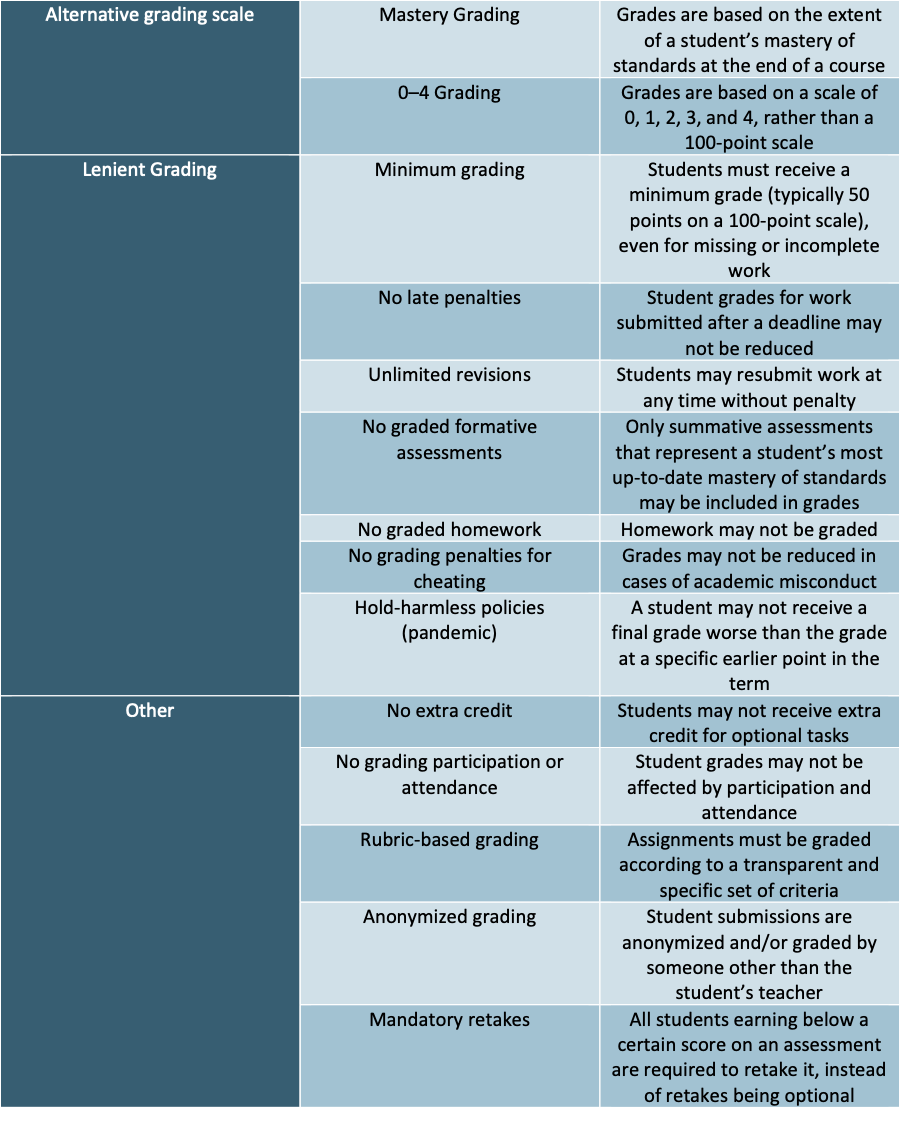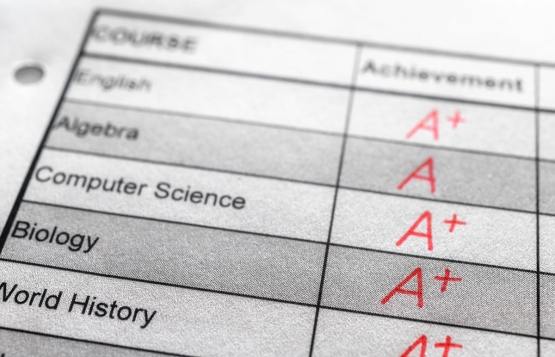This is the seventh in a series on doing educational equity right. See the introductory post, as well as essays on school finance, student discipline, advanced education, school closures, homework, effective teachers, and a concluding post on doing educational equity wrong.
Student grading is one of those issues that has an enormous impact on kids and schools, yet for years it remained almost completely under the radar. Barely discussed in teacher preparation programs, rarely a topic in professional development sessions, there must have been an assumption that there was nothing much to it or that everyone knew how to do it well.
Thanks to a few intrepid advocates, including Joe Feldman and Douglas Reeves, the issue is a sleeper no more. As these and other analysts and commentators correctly observe, how we grade student work is one of the most important ways that we communicate expectations to youngsters, as well as relay critical information to parents, institutions of higher education, and potential employers. Yet as these folks explain, traditional grading practices can be riddled with bias, including racial bias. Hence the drive for “equitable grading,” which seeks to squeeze this bias out of the system.
So far so good. Yet like so many things in today’s K–12 world, “equitable grading” has often been implemented piecemeal, bringing along with it all manner of unintended consequences, the most important of which is lowered standards.
A new white paper by my colleagues Meredith Coffey and Adam Tyner, part of our “Think Again” series, unpacks all this. Here’s a useful table from their paper that illustrates the scope of what we’re talking about:
Table 1: Equity-oriented grading policies

So how can school districts “do educational equity right” when it comes to grading? To address concerns about bias while keeping standards high? Let’s return to this series’ three big rules:
- When aiming for equity, we should level up instead of leveling down.
- We should focus on closing gaps between affluent students and their disadvantaged peers, not between high-achieving students and their lower-achieving peers.
- We should focus equity initiatives primarily on class, not race.
Grading practices that level up instead of leveling down
This is the heart of the matter. As we discussed in our homework post, student effort is key to student learning. Especially as kids get older, they cannot master challenging material by osmosis. They have to put in the work—do the practice math problems, write and re-write and re-write the research paper, study for their history and science tests. And regardless of what you might have read by Jean-Jacques Rousseau or Alfie Kohn, most adolescents are not going to choose to spend extra time and effort on schoolwork because of their intrinsic love of learning.
Tough grading practices, then, are essential to motivating students to work harder. Indeed, several research studies, including a Seth Gershenson paper published by Fordham, demonstrate that teachers who are tougher graders have a clear positive impact on learning, even after their students leave their classrooms. That goes for students from all racial subgroups and those in high-poverty schools. If we’re making it easier for students to get A’s and B’s, that’s a problem.
Yet there’s no doubt that we’re making it easier. The evidence on grade inflation continues to pile up. Like so many negative trends in U.S. schools, this phenomenon started before the pandemic, but the Covid era made it markedly worse. That’s partly because schools understandably relaxed standards while kids were Zoom-schooling, but it’s also the case that the push for “equity” in grading gained steam after the racial reckoning of 2020.
Now we’re in a situation wherein elite colleges can’t rely on student grades to send clear signals because almost everyone applying for admission gets straight A’s. On the other end of the academic spectrum, our high school graduation rate is higher than ever, in part because standards for graduation—which are of course tied to getting passing grades in required courses—are lower than ever (yay?).
What this all means is that we need to take a critical eye to any grading practices that have the effect of lowering standards—even if their advocates didn’t intend them to. In that bucket I’d include the “50 percent rule”—mandating that teachers give no lower than a 50 percent on any test or assignment, even those that kids don’t turn in. For obvious reasons (at least obvious to anyone who has met a teenager or ever been one), some kids will adapt to this system and put in less work. Likewise with bans on grading homework, even for completion. Like many of us, kids need someone to hold them accountable for doing what’s in their own long-term self-interest. And that means hitting the books, doing their homework, and getting feedback on whether they did it well. Same with banning penalties for late work, or even cheating.
That leaves plenty of other grading reforms that are still worth embracing—those that are focused on maintaining high standards while reducing bias—as we’ll discuss below.
Grading reforms and high versus low achievers
One of the major arguments for practices like the 50 percent rule is that giving a kid a zero on a big assignment will tank their grade and encourage them to give up. That’s certainly a possibility. Zero is indeed a long distance from 60 percent, the traditional minimum score for a passing grade, and it very well might be mathematically impossible for a student to make up enough ground to pass a course if they are staring at a goose egg.
But these across-the-board rules don’t just impact the lowest-achieving students—those kids at risk of not passing their courses. They impact everybody—including the strivers and grinders. And those high achievers will adapt their behavior to the new policies, too. If they build up a high-enough A early in the quarter, they know they can bomb some later quizzes or skip some assignments and still get what they need for their transcripts. So they put in less work. That’s not good! (And please keep in mind, plenty of these high achievers are students from disadvantaged backgrounds, so it’s not good for equity either.)
A better approach, then, is to return authority to teachers over their grading practices so they can offer grace to students on a case-by-case basis. If students bomb a big assignment or test early in the quarter, their teachers can make it clear to them that, if they get their act together and do better on future assessments, those zeroes will be adjusted upward. That’s a much better solution than schoolwide or districtwide rules that apply to everyone.
What about bias?
Now for some grading reforms that are well worth supporting: those that indicate higher expectations and work to reduce bias. The bias piece is important; whether it’s because of students’ socioeconomic backgrounds, or race, or the intersection of the two, it’s not hard to see how unintentional bias can creep into the grading process. On the one hand, a teacher might go a little easier on a kid knowing the hardships he or she is facing at home—the soft bigotry of low expectations. Alternatively, a teacher might anticipate lower-quality work from a student given their zip code or appearance—or just their performance on previous assignments.
Thus, various forms of blind grading are to be commended. They could involve electronic grading systems whereby teachers don’t see the students’ name until after they’ve completed their evaluations, or mechanisms whereby teachers grade papers and tests from other teachers’ students. Regardless, those doing the grading benefit from clear rubrics, ideally those that enforce a tough standard for what it takes to be considered A-level work. These sorts of approaches are, of course, at the heart of the Advanced Placement and International Baccalaureate programs and how they evaluate student exams.
Let’s be clear though: We shouldn’t expect blind grading or similar techniques to eliminate disparities in student grades by race or ethnicity. As long as we have achievement gaps—and sadly, they remain quite large—we are going to see GPA gaps, as well.
—
The “grading reformers” have performed an important service by surfacing this issue as a critical topic. It’s nuts that for decades we largely just expected teachers to figure out grading on their own and put so little effort into making sure that grade expectations were consistent across schools or districts—or even classrooms!
But some grading reforms are better than others. Educational leaders: Be discerning. Empower your teachers. By all means work to eliminate bias. But make sure that, whatever you do, you keep expectations high.









